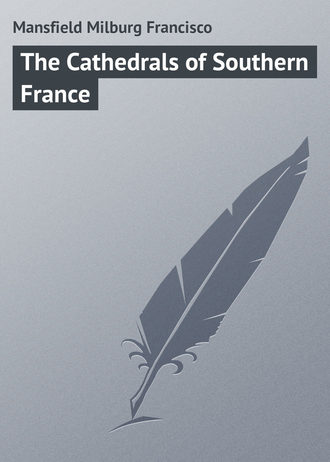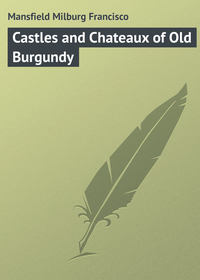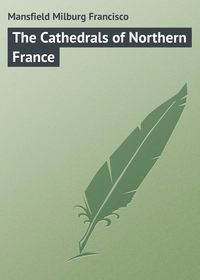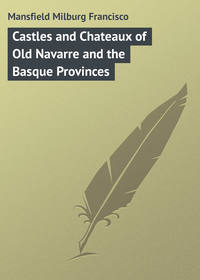 полная версия
полная версияThe Cathedrals of Southern France
This wonderful sixteenth-century Église de Brou, in a highly decorated Gothic style, its monuments, altars, and admirable glass, is not elsewhere equalled, as to elaborateness, in any church of its size or rank.
Notre Dame de Bourg – the cathedral – though manifestly a Renaissance structure, has not a little of the Gothic spirit in its interior arrangements and details. It is as if a Renaissance shell – and not a handsome one – were enclosing a Gothic treasure.
There is the unusual polygonal apside, which dates from the fifteenth or sixteenth century, and is the most curious part of the entire edifice.
The octagonal tower of the west has, in its higher story, been replaced by an ugly dome-shaped excrescence surmounted by an enormous gilded cross which is by no means beautiful.
The west façade in general, in whose portal are shown some evidences of the Gothic spirit, which at the time of its erection had not wholly died, is uninteresting and all out of proportion to a church of its rank.
The interior effect somewhat redeems the unpromising exterior.
There is a magnificent marble high-altar, jewel-wrought and of much splendour. The two chapels have modern glass. A fine head of Christ, carved in ivory, is to be seen in the sacristy. Previous to 1789 it was kept in the great council-chamber of the États de la Bresse.
In the sacristy also there are two pictures, of the German school of the sixteenth century.
There are sixty-eight stalls, of the sixteenth century, carved in wood. Curiously enough, these stalls – of most excellent workmanship – are not placed within the regulation confines of the choir, but are ranged in two rows along the wall of the apside.
XXIV
GLANDÈVE, SENEZ, RIEZ, SISTERON
The diocese of Digne now includes four ci-devant bishoprics, each of which was suppressed at the Revolution.
The ruins of the ancient bishopric of Glandève are to-day replaced by the small town of D'Entrevaux, whose former cathedral of St. Just has now disappeared. The see of Glandève had in all fifty-three bishops, the first – St. Fraterne – in the year 459.
Senez was composed of but thirty-two parishes. It was, however, a very ancient foundation, dating from 445 A. D. Its cathedral was known as Notre Dame, and its chapter was composed of five canons and three dignitaries. At various times forty-three bishops occupied the episcopal throne at Senez.
The suppression likewise made way with the bishopric at Riez, a charming little city of Provence. The see was formerly composed of fifty-four parishes, and its cathedral of Notre Dame had a chapter of eight canons and four dignitaries. The first bishop was St. Prosper, in the early part of the fifth century. Ultimately he was followed by seventy-four others. Two "councils of the church" were held at Riez, the first in 439, and the second in 1285.
The diocese of Sisteron was situated in the charming mountain town of the Basses-Alps. This brisk little fortress-city still offers to the traveller many of the attractions of yore, though its former cathedral of Notre Dame no longer shelters a bishop's throne.
Four dignitaries and eight canons performed the functions of the cathedral, and served the fifty parishes allied with it.
The first bishop was Chrysaphius, in 452, and the last, François Bovet, in 1789. This prelate in 1801 refused the oath of allegiance demanded by the new régime, and forthwith resigned, when the see was combined with that of Digne.
The ancient cathedral of Notre Dame de Sisteron of the eleventh and twelfth centuries is now ranked as a "Monument Historique." It dates, in the main, from the twelfth century, and is of itself no more remarkable than many of the other minor cathedrals of this part of France.
Its chief distinction lies in its grand retable, which is decorated with a series of superb paintings by Mignard.
The city lies picturesquely posed at the foot of a commanding height, which in turn is surmounted by the ancient citadel. Across the defile, which is deeply cut by the river Durance, rises the precipitous Mont de la Baume, which, with the not very grand or splendid buildings of the city itself, composes the ensemble at once into a distinctively "old-world" spot, which the march of progress has done little to temper.
It looks not a little like a piece of stage-scenery, to be sure, but it is a wonderful grouping of the works of nature and of the hand of man, and one which it will be difficult to duplicate elsewhere in France; in fact, it will not be possible to do so.
XXV
ST. JEROME DE DIGNE
The diocese of Digne, among all of its neighbours, has survived until to-day. It is a suffragan of Aix, Arles, and Embrun, and has jurisdiction over the whole of the Department of the Basses-Alps. St. Domnin became its first bishop, in the fourth century.
The ancient Romanesque cathedral of Notre Dame – from which the bishop's seat has been removed to the more modern St. Jerome – is an unusually interesting old church, though bare and unpretentious to-day. It dates from the twelfth century, and has all the distinguishing marks of its era. Its nave is, moreover, a really fine work, and worthy to rank with many more important. There are, in this nave, some traces of a series of curious wall-paintings dating from the fourteenth or fifteenth centuries.
St. Jerome de Digne – called la cathédrale fort magnifiante– is a restored Gothic church of the early ages of the style, though it has been placed – in some doubt – as of the fifteenth century.
The apse is semicircular, without chapels, and the general effect of the interior as a whole is curiously marred by reason of the lack of transepts, clerestory, and triforium.
This notable poverty of feature is perhaps made up for by the amplified side aisles, which are doubled throughout.
The western portal, which is of an acceptable modern Gothic, is of more than usual interest as to its decorations. In the tympanum of the arch is a figure of the Saviour giving his blessing, with the emblems of the Evangelists below, and an angel and the pelican – the emblem of the sacrament – above. Beneath the figure of the Saviour is another of St. Jerome, the patron, to whom the cathedral is dedicated.
A square, ungainly tower holds a noisy peal of bells, which, though a great source of local pride, can but prove annoying to the stranger, with their importunate and unseemly clanging.
The chief accessories, in the interior, are an elaborate organ-case, – of the usual doubtful taste, – a marble statue of St. Vincent de Paul (by Daumas, 1869), and a sixteenth or seventeenth-century statue of a former bishop of the diocese.
Digne has perhaps a more than ordinary share of picturesque environment, seated, as it is, luxuriously in the lap of the surrounding mountains.
St. Domnin, the first bishop, came, it is said, from Africa at a period variously stated as from 330 to 340 A. D., but, at any rate, well on into the fourth century. His enthronement appears to have been undertaken amid much heretical strife, and was only accomplished with the aid of St. Marcellin, the archbishop of Embrun, of which the diocese of Digne was formerly a suffragan.
The good St. Domnin does not appear to have made great headway in putting out the flame of heresy, though his zeal was great and his miracles many. He departed this world before the dawn of the fifth century, and his memory is still brought to the minds of the communicants of the cathedral each year on the 13th of February – his fête-day – by the display of a reliquary, which is said to contain – somewhat unemphatically – the remains of his head and arm.
Wonderful cures are supposed to result to the infirm who view this relique in a proper spirit of veneration, and devils are warranted to be cast out from the true believer under like conditions.
A council of the Church was held at Digne in 1414.
XXVI
NOTRE DAME DE DIE
The Augusta Dia of the Romans is to-day a diminutive French town lying at the foot of the colline whose apex was formerly surmounted by the more ancient city.
It takes but little ecclesiastical rank, and is not even a tourist resort of renown. It is, however, a shrine which encloses and surrounds many monuments of the days which are gone, and is possessed of an ancient Arc de Triomphe which would attract many of the genus "touriste", did they but realize its charm.
The cathedral, dedicated to the Virgin, sheltered a bishop's throne from the foundation of the bishopric until 1285, when a hiatus ensued – apparently from some inexplicable reason – until 1672, when its episcopal dignity again came into being. Finally, in 1801, the diocese came to an end. St. Mars was the first bishop, the see having been founded in the third century.
The porch of this cathedral is truly remarkable, having been taken from a former temple to Cybele, and dates at least from some years previous to the eleventh century. Another portal of more than usual remark – known as the porte rouge– is fashioned from contemporary fragments of the same period.
While to all intents and purposes the cathedral is an early architectural work, its rank to-day is that of a restored or rebuilt church of the seventeenth century.
The nave is one of the largest in this part of France, being 270 feet in length and seventy-six feet in width. It has no side aisles and is entirely without pillars to break its area, which of course appears more vast than it really is.
What indications there are which would place the cathedral among any of the distinct architectural styles are of the pointed variety.
Aside from its magnificent dimensions, there are no interior features of remark except a gorgeous Renaissance pulpit and a curious cène.
XXVII
NOTRE DAME ET ST. CASTOR D'APT
Apt is doubtfully claimed to have been a bishopric under St. Auspice in the first century, but the ancient Apta Julia of Roman times is to-day little more than an interesting by-point, with but little importance in either ecclesiological or art matters.
Its cathedral – as a cathedral – ceased to exist in 1790. It is of the species which would be generally accepted as Gothic, so far as exterior appearances go, but it is bare and poor in ornament and design, and as a type ranks far down the scale.
In its interior arrangements the style becomes more florid, and takes on something of the elaborateness which in a more thoroughly worthy structure would be unremarked.
The chief decoration lies in the rather elaborate jubé, or choir-screen, which stands out far more prominently than any other interior feature, and is without doubt an admirable example of this not too frequent attribute of a French church.
Throughout there are indications of the work of many epochs and eras, from the crypt of the primitive church to the Chapelle de Ste. Anne, constructed by Mansard in the seventeenth century. This chapel contains some creditable paintings by Parrocel, and yet others, in a still better style, by Mignard.
The crypt, which formed a part of the earlier church on this site, is the truly picturesque feature of the cathedral at Apt, and, like many of its kind, is now given over to a series of subterranean chapels.
Among the other attributes of the interior are a tomb of the Ducs de Sabron, a marble altar of the twelfth century, a precious enamel of the same era, and a Gallo-Romain sarcophagus of the fifth century.
As to the exterior effect and ensemble, the cathedral is hardly to be remarked, either in size or splendour, from the usual parish church of the average small town of France. It does not rise to a very ambitious height, neither does its ground-plan suggest magnificent proportions. Altogether it proves to be a cathedral which is neither very interesting nor even picturesque.
The little city itself is charmingly situated on the banks of the Coulon, a small stream which runs gaily on its way to the Durance, at times torrential, which in turn goes to swell the flood of the Rhône below Avignon.
The former bishop's palace is now the préfecture and Mairie.
XXVIII
NOTRE DAME D'EMBRUN
Embrun, not unlike its neighbouring towns in the valley of the Durance, is possessed of the same picturesque environment as Sisteron and Digne. It is perched high on that species of eminence known in France as a colline, though in this case it does not rise to a very magnificent height; what there is of it, however, serves to accentuate the picturesque element as nothing else would.
The episcopal dignity of the town is only partial; it shares the distinction with Aix and Arles.
The Église Notre Dame, though it is still locally known as "la cathédrale," is of the twelfth century, and has a wonderful old Romanesque north porch and peristyle set about with gracefully proportioned columns, the two foremost of which are supported upon the backs of a pair of weird-looking animals, which are supposed to represent the twelfth-century stone-cutter's conception of the king of beasts. In the tympanum of this portal are sculptured figures of Christ and the Evangelists, in no wise of remarkable quality, but indicating, with the other decorative features, a certain luxuriance which is not otherwise suggested in the edifice.
The Romanesque tower which belongs to the church proper is, as to its foundations, of very early date, though, as a finished detail, it is merely a rebuilt fourteenth-century structure carried out on the old lines. There is another tower, commonly called "la tour brune," which adjoins the ancient bishop's palace, and dates from at least a century before the main body of the church.
The entire edifice presents an architectural mélange that makes it impossible to classify it as of any one specific style, but the opinion is hazarded that it is all the more interesting a shrine because of this incongruity.
The choir, too, indicates that it has been built up from fragments of a former fabric, while the west front is equally unconvincing, and has the added curious effect of presenting a variegated façade, which is, to say the least and the most, very unusual. A similar suggestion is found occasionally in the Auvergne, but the interweaving of party-coloured stone, in an attempt to produce variety, has too often not been taken advantage of. In this case it is not so very pleasing, but one has a sort of sympathetic regard for it nevertheless.
In the interior there are no constructive features of remark; indeed there is little embellishment of any sort. There is an eighteenth-century altar, in precious marbles, worked after the old manner, and in the sacristy some altar-fittings of elaborately worked Cordovan leather, a triptych which is dated 1518, some brilliant glass of the fifteenth century, and in the nave a Renaissance organ-case which encloses an organ of the early sixteenth century.
Near by is Mont St. Guillaume (2,686 metres), on whose heights is a sanctuaire frequented by pilgrims from round about the whole valley of the Durance.
From "Quentin Durward," one recalls the great devotion of the Dauphin of France – Louis XI. – for the statue of Notre Dame d'Embrun.
XXIX
NOTRE DAME DE L'ASSOMPTION DE GAP
Gap is an ancient and most attractive little city of the Maritime Alps, of something less than ten thousand inhabitants.
Its cathedral is also the parish church, which suggests that the city is not especially devout.
The chapter of the cathedral consists of eight canons, who, considering that the spiritual life of the entire Department of the Hautes-Alpes – some hundred and fifty thousand souls – is in their care, must have a very busy time of it.
St. Demetrius, the friend of St. John the Evangelist, has always been regarded as the first apostle and bishop of the diocese. He came from Rome to Gaul in the reign of Claudian, and began his work of evangelization in the environs of Vienne under St. Crescent, the disciple of St. Paul. From Vienne Demetrius came immediately to Gap and established the diocese here.
Numerous conversions were made and the Church quickly gained adherents, but persecution was yet rife, as likewise was superstition, and the priests were denounced to the governors of the province, who forthwith put them to death in true barbaric fashion.
Amid these inflictions, however, and the later Protestant persecutions in Dauphiné, the diocese grew to great importance, and endures to-day as a suffragan of Aix, Arles, and Embrun.
The Église de Gap has even yet the good fortune to possess personal reliques of her first bishop, and accordingly displays them with due pride and ceremony on his jour de fête, the 26th October of each year. Says a willing but unknowing French writer: "Had Demetrius – who came to Gap in the first century – any immediate successors? That we cannot say. It is a period of three hundred years which separates his tenure from that of St. Constantine, the next prelate of whom the records tell."
Three other dioceses of the former ecclesiastical province have been suppressed, and Gap alone has lived to exert its tiny sphere of influence upon the religious life of the present day.
The history of Gap has been largely identified with the Protestant cause in Dauphiné. There is, in the Prefecture, a monument to the Due de Lesdiguières – Françoise de Bonne – who, from the leadership of the Protestants went over to the Roman faith, in consideration of his being given the rank of Connétable de France. Why the mere fact of his apostasy should have been a sufficient and good reason for this aggrandizement, it is difficult to realize in this late day; though we know of a former telegraph messenger who became a count.
Another reformer, Guillaume Farel, was born and lived at Gap. "He preached his first sermon," says History, "at the mill of Burée, and his followers soon drove the Catholics from the place; when he himself took possession of the pulpits of the town."
From all this dissension from the Roman faith – though it came comparatively late in point of time – rose the apparent apathy for church-building which resulted in the rather inferior cathedral at Gap.
No account of this unimportant church edifice could possibly be justly coloured with enthusiasm. It is not wholly a mean structure, but it is unworthy of the great activities of the religious devotion of the past, and has no pretence to architectural worth, nor has it any of the splendid appointments which are usually associated with the seat of a bishop's throne.
Notre Dame de l'Assomption is a modern edifice in the style Romano-Gothique, and its construction, though elaborate both inside and out, is quite unappealing.
This is the more to be marvelled at, in that the history of the diocese is so full of incident; so far, in fact, in advance of what the tangible evidences would indicate.
XXX
NOTRE DAME DE VENCE
Vence, – the ancient Roman city of Ventium, – with five other dioceses of the ecclesiastical province of Embrun, was suppressed – as the seat of a bishop – in 1790. It had been a suffragan bishopric of Embrun since its foundation by Eusèbe in the fourth century.
The ancient cathedral of Notre Dame is supposed to show traces of workmanship of the sixth, tenth, twelfth, and fifteenth centuries, but, excepting that of the latter era, it will be difficult for the casual observer to place the distinctions of style.
The whole ensemble is of grim appearance; so much so that one need not hesitate to place it well down in the ranks of the church-builder's art, and, either from poverty of purse or purpose, it is quite undistinguished.
In its interior there are a few features of unusual remark: an ancient sarcophagus, called that of St. Véran; a retable of the sixteenth century; some rather good paintings, by artists apparently unknown; and a series of fifty-one fifteenth-century choir-stalls of quite notable excellence, and worth more as an expression of artistic feeling than all the other features combined.
The only distinction as to constructive features is the fact that there are no transepts, and that the aisles which surround the nave are doubled.
XXXI
CATHÉDRALE DE SION
The small city of Sion, the capital of the Valais, looks not unlike the pictures one sees in sixteenth-century historical works.
It is brief, confined, and unobtrusive. It was so in feudal times, when most of its architecture partook of the nature of a stronghold. It is so to-day, because little of modernity has come into its life.
The city, town, or finally village – for it is hardly more, from its great lack of activity – lies at the foot of three lofty, isolated eminences. A great conflagration came to Sion early in the nineteenth century which resulted in a new lay-out of the town and one really fine modern thoroughfare, though be it still remarked its life is yet mediæval.
Upon one of these overshadowing heights is the present episcopal residence, and on another the remains of a fortress – formerly the stronghold of the bishops of Sion. On this height of La Valère stands the very ancient church of Ste. Catherine (with a tenth or eleventh-century choir), occupying, it is said, the site of a Roman temple.
In the mid-nineteenth century the Jesuits gained a considerable influence here and congregated in large numbers.
The city was the ancient Sedanum, and in olden time the bishop bore also the title of "Prince of the Holy Empire." The power of this prelate was practically unlimited, and ordinances of state were, as late as the beginning of the nineteenth century, made in his name, and his arms formed the embellishments of the public buildings and boundary posts.
Rudolf III., king of Burgundy, from the year 1000, made them counts of Valais.
St. Théodule was the first bishop of Sion, – in the fourth century, – and is the patron of the diocese.
In 1070 the bishop of Sion came to England as papal legate to consecrate Walkelin to the see of Winchester.
In 1516 Bishop Schinner came to England to procure financial aid from Henry VIII. to carry on war against France.
The cathedral in the lower town is a fifteenth-century work which ought – had the manner of church-building here in this isolated region kept pace with the outside world – to be Renaissance in style. In reality, it suggests nothing but the earliest of Gothic, and, in parts, even Romanesque; therefore it is to be remarked, if not admired.
Near by is the modern episcopal residence.
The records tell of the extraordinary beauty and value of the trésor, which formerly belonged to the cathedral: an ivory pyx, a reliquary, and a magnificent manuscript of the Gospels – given by Charles the Great to St. Maurice, and acquired by the town in the fourteenth century. This must at some former time have been dispersed, as no trace of it is known to-day.
Sion was formerly a suffragan bishopric of Tarantaise, which in turn has become to-day a suffragan of Chambéry.
XXXII
ST. PAUL TROIS CHÂTEAUX
St. Paul Trois Châteaux is a very old settlement. As a bishopric it was known anciently as Tricastin, and dates from the second century. St. Restuit was its first bishop. It was formerly the seat of the ancient Roman colony of Augusta Tricastinorum. Tradition is responsible for the assertion that St. Paul was the first prelate of the diocese, and being born blind was cured by Jesus Christ. This holy man, after having recovered his sight, took the name of Restuit, under which name he is still locally honoured. One of his successors erected to his honour, in the fourth century, a chapel and an altar. These, of course have disappeared – hence we have only tradition, which, to say the least, and the most, is, in this case, quite legendary.
The city was devastated in the fifth century by the Vandals; in 1736 by the Saracens; and taken and retaken by the Protestants and Catholics in the fourteenth century.
As a bishopric the "Tricastin city" comprised but thirty-six parishes, and in the rearrangement attendant upon the Revolution was suppressed altogether. Ninety-five bishops in all had their seats here up to the time of suppression. Certainly the religious history of this tiny city has been most vigorous and active.









